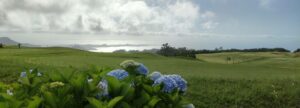You will be amazed!
The flower island Madeira truly lives up to its name, because you can admire the most magnificent flowering plants here all year round. Many plants from tropical and subtropical countries were imported to the island, mainly by the English. They became at home here with the constant mild temperatures, spread more and more and today beautify the whole island.
Every season has its peculiarity: in winter the poinsettia and tree aloe unfold, in early spring tree-sized rhododendrons and the magnificent rosewood trees with their deep blue flowers bloom. And all over the roadsides, African love flowers grow, which unfold their splendor from the end of May. Summer is the time of the hydrangeas and in autumn you can admire the pink calyx of the kapok tree, especially in Funchal. Not to be forgotten are hibiscus and bougainvillea, which bloom all year round and especially beautify the dried up river valleys of Funchal.
The native flora, on the other hand, is quite inconspicuous. Around 800 flowering plants made the long way across the Atlantic before colonization, mostly fern, moss and mushroom species. Because of the isolated location, the flora here went through its own development, so that today around 15% of all species are endemic.
Due to the climatic differences, there are several vegetation levels. In the coastal area up to about 300 m height you will find the magnificent adder head with its blue, candle-shaped inflorescences in spring. In addition, milkweed plants, the wild olive tree and a few dragon trees.
It rains more often between 300 and 600 m altitude. Canarian laurel, wax myrtle and Canarian willow grow there. Between 600 and 1.300 m you can see eucalyptus trees, maritime pines and the laurel forest, which is particularly important for the island's water supply. Unfortunately, the laurel forest is threatened by foreign plants, semi-wild goats, sheep and pigs that eat young shoots, but also by forest fires that afflict Madeira every year.
The laurel forest holds the water by its undergrowth, directs it into the ground, where it is stored in the porous rock layers. So there is a constant supply of water even in seasons with little rain. In addition, the effects of heavy precipitation are dampened and soil erosion is reduced. That is why the Madeirans, with the help of the EU, are fighting against the destruction of the laurel forest by trying to reforest it. This is happening with some success, but the afforestation takes time and larger stands of laurel trees can currently only be found on the north side of Madeira.
From an altitude of 1.300 m, the vegetation changes completely (Paúl da Serra plateau). There you will only find tree heather, the Madeira blueberry and the bracken, which takes up huge areas there.






